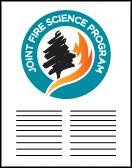United States Joint Fire Science Program
Document Type
Article
Date of this Version
2009
Citation
Project Active ID: 08-S-08
Abstract
Department of the Interior (DOI) bureaus have invested heavily (for example, the U.S. Bureau of Land Management (BLM) spent more than $60 million in fiscal year 2007) in seeding vegetation for emergency stabilization and burned area rehabilitation of non-forested arid lands over the past 10 years. The primary objectives of these seedings commonly are to (1) reduce the post-fire dominance of non-native annual grasses, such as cheatgrass (Bromus tectorum) and red brome (Bromus rubens); (2) minimize the probability of recurrent fire; and (3) ultimately produce desirable vegetation characteristics (for example, ability to recover following disturbance [resilience], resistance to invasive species, and a capacity to support a diverse flora and fauna). Although these projects historically have been monitored to varying extents, land managers currently lack scientific evidence to verify whether seeding arid and semiarid lands achieves desired objectives. Given the amount of resources dedicated to post-fire seeding projects, a synthesis of information determining the factors that result in successful treatments is critically needed. Although results of recently established experiments and monitoring projects eventually will provide useful insights for the future direction of emergency stabilization and burned area rehabilitation programs, a chronosequence approach evaluating emergency stabilization and burned area rehabilitation treatments (both referenced hereafter as ESR treatments) over the past 30 years could provide a comprehensive assessment of treatment success across a range of regional environmental gradients. By randomly selecting a statistically robust sample from the population of historic ESR treatments in the Intermountain West, this chronosequence approach would have inference for most ecological sites in this region. The goal of this feasibility study was to compile and examine historic ESR records from BLM field offices across the Intermountain West to determine whether sufficient documentation existed for a future field-based chronosequence project. We collected ESR records and data at nine BLM field offices in four States (Oregon, Idaho, Nevada, and Utah) and examined the utility of these data for the development of a chronosequence study of post-fire seeding treatments from multiple sites and different ages (since seeding) throughout the Intermountain West. We collected records from 730 post-fire seeding projects with 1,238 individual seeding treatments. Records from each project ranged from minimal reporting of the project’s occurrence to detailed documentation of planning, implementation, and monitoring. Of these 1,238 projects, we identified 468 (38 percent) that could potentially be used to implement a field-based chronosequence study. There were 206 ground-seeding treatments and 262 aerial-seeding treatments within this initial population, not including hand plantings. We also located a considerable number of additional records from other potential field offices that would be available for the chronosequence study but have yet to be compiled for this feasibility report.
Included in
Forest Biology Commons, Forest Management Commons, Natural Resources and Conservation Commons, Natural Resources Management and Policy Commons, Other Environmental Sciences Commons, Other Forestry and Forest Sciences Commons, Sustainability Commons, Wood Science and Pulp, Paper Technology Commons



Comments
U.S. Government Work